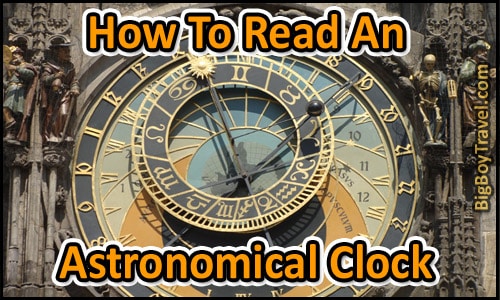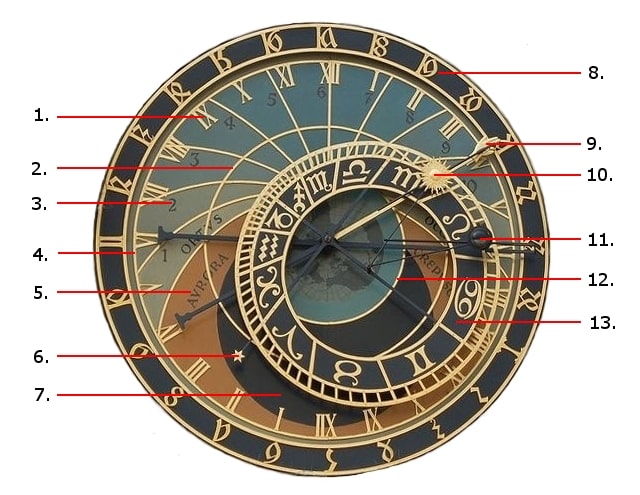

Prague’s Astronomical Clock:

The Astronomical Clock (Pražský Orloj) in Prague is one of the highlights of Old Town Square and one of the top sights in the entire city. Most tourist think its cool, take and photo and move on, but the clock is even cooler if you know how to read it. The clock itself is made of 3 parts the Astronomical Dial (shown to the right), the Walk of the Apostles Figurines, and the Zodiac Dial on the bottom. There is a lot going on with the clock which can be overwhelming, but we will try our best to make it easy.
How to read Prague’s Astronomical Clock:
The Astronomical Dial (shown to the right) is the time telling part of the clock and was built in 1410. It shows position of the Sun (10) and Moon (11) in the sky with a mechanical clock in the center of it.
The first thing to examine is the stationary background of the Astronomical Dial which pins you the observer standing in Prague right in the center of an Earthly map. Surrounding the Earth are colored rings that represent the current sun light with the bottom dark circle being night time (7), the orange to the left being day break (5), the grey to the left being sunrise (4), the blue on the top being daytime (2), the grey on the right being sunset, the orange on the right being twilight, working your way be to night time. These colored rings for the daylight move throughout the year as the days grow longer and shorter.
On the edges the of the Astronomical Dial the ring of Roman Numerals show the Modern 24 Hour Clock (1) we are used to today set to Central European Time. Follow the Golden Hand (9) to see the current time on the standard 24 hour clock. Outside of the standard Roman Numerals is another ring with Schwabacher Numerals showing Ancient Bohemian Time (8) that went off Italian hours. In Italian hours they still used a 24 hour day, but the day ended and reset officially at sunset. Throughout the year the the ring of Schwabacher Numerals rotates to keep the end of the day lined up with sunset which can be anywhere from 4-8pm during the year using modern hours. Easiest way to think of it is that Sunset is 0 hours and each hour is the time after Sunset.
When using the ancient Czech time it is important to know that while they changed when the day ended based on the length of daylight, the day light and night time hours were always divided up into 12 parts each regardless. Because the length of the day time changes throughout the year they used an odd system called Unequal Hours or Planetary Hours where the length of the 12 daytime and 12 night time hours themselves changed in to keep 12 night hours and 12 day hours. The position of the Gold Sun on the Golden Hand in relation to the Golden Arch Lines on the background will tell you what time it is based on Unequal Hours. Notice how the Arch Lines on the top of the clock have the numbers 1-12 on them going from Sunrise on the left to Sunset on the right? The Gold Sun moves up and down the Golden Hand throughout the year to narrower or wider spots in the Golden Arch Lines showing the Unequal hours are longer or shorter.
The Moon along the Zodiac Ring (13) spins around the clock representing its orbit around the Earth and it also has both a black and white half that rotate to show the current cycle of the Moon. The Zodiac Ring moves so the sun goes across it counterclockwise marking the current position in the Zodiac year.
The small Golden Star (6) shows the position of the vernal equinox and measures Siderial Time based on its positions in relation to the Roman Numerals on the outer ring.
The relation of all the celestial items are a little weird today as when the clock was built most people believe that everything revolved around the Earth on an ecliptic plane and it wasn’t until the 1500s that it was discovered we are in a solar system going around the our sun. Remember from stop 3 that it was right here in Old Town Prague where another Astronomical break through happened in 1619 when Kepler came up with his Laws of Planetary Motion.
Calendar Dial added in 1870. The center has the crest of Old Town Prague surrounded by the 12 Zodiac symbols of pre-2012 lining up with the days they fall on laying on the outer ring with has marks for each day of the year. The Dial rotates keeping the current day on the top.
The Walk of the Apostles, animated statues added in the 1600s, Apostle statues added in 1865, statues come alive hourly, the skeleton statue representing Death is our favorite as it appears to be striking along with the hourly bells.
From left to right in the photographs, the first is Vanity, represented by a figure admiring himself in a mirror. Next, the miser holding a bag of gold represents greed or usury. Across the clock stands Death, a skeleton that strikes the time upon the hour. Finally, the Turk tells pleasure and entertainment.




